Preview season is one of my favorite times of year. Magic players get to huddle around MythicSpoiler or their news source of choice, eagerly awaiting the latest updates from content creators around the world as they show off the latest cards.
These are normally spread out a bit over the course of a week or 3, but the abnormal circumstances we’ve been dealing with around the world, paired with the experiment of releasing a Commander product alongside a major set release, meant we got most new cards over the course of a weekend. In the middle of the spoiler season for Ikoria: Lair of Behemoths.
I’ll be honest – it was a little much.
Don’t get me wrong – I love being excited for new Magic cards, and I didn’t think there was a firehose with enough information to overwhelm me. As of this spoiler season, I found out otherwise, so it has taken me a while to fully process what Ikoria’s 2020 Commander product is offering, and I have to say, it doesn’t disappoint.
There are some exciting cards to support strategies that could use a little extra love, variations for Commanders of existing strategies in different colors, and some generally powerful cards many decks will gladly take advantage of.
Today’s top 10 will largely be discussing the last of these categories, as they hold the widest range of applications for the average player, but I’ll also be including a couple Commanders on this list you should keep an eye out for during in-person game nights as well as remote games using untap.in or a SpellTable setup. As with my other top 10s, these entries are also not presented in a particular order in terms of power level, and only include brand new cards. Without further ado, let’s check out the new hotness!
Verge Rangers

Those who have played in and/or followed the Commander format for a while probably know this already, but white is widely considered the weakest color of the format right now. The efficient creatures that cost 3 or less mana (which has long been a strength of white, dating back to the Alpha release of Savannah Lions) simply cannot get through Commander’s starting life total of 40 reliably, let alone for multiple opponents. The last several new releases have not been of terribly much help in correcting this view either, especially as we watch chase card after chase card come out that is green and/or blue.
White has other strengths though, and this represents an important step toward bringing them into the spotlight.
Verge Rangers is probably the strongest push toward showcasing white’s role in the color pie as a secondary mana accelerator/fixer since Smothering Tithe (green being the primary). Creatures like Oracle of Mul Daya and Courser of Kruphix have been popular for some time, and this card gives you the same ability to play lands off the top of your library – so long as an opponent has more.
This plays toward the idea of fairness and balance white has been historically known for, so the ability being printed here with a slight restriction feels on point. It’s stapled to an efficient 3/3 body with first strike for 3 mana, so your opponents will have a harder time getting early damage in on you. You can take further advantage of it by using cards like Sensei’s Divining Top to rearrange the top of your library or by utilizing cards that shuffle your deck to change the top card, which in turn can help you reduce dead draws.
Verge Rangers is the total package, and I expect it to become very popular in short order – don’t wait too long to get your copies.
Species Specialist
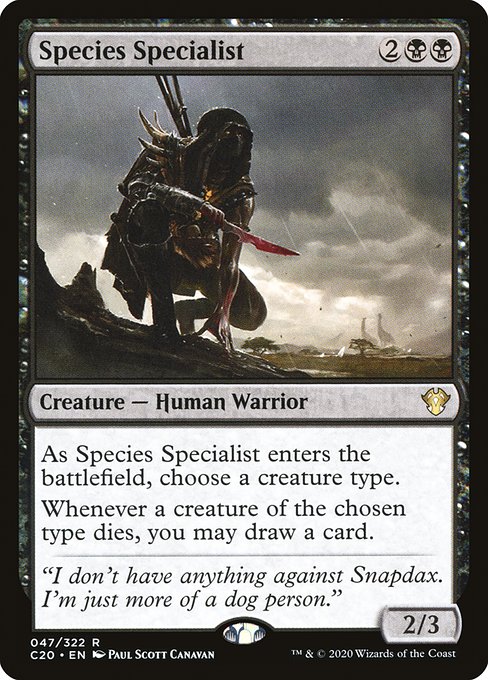
Tribal decks, or decks that revolve around creatures of a specific creature type, have been popular since Commander was commonly referred to as EDH (my favorites are Slivers and Angels, and I’m currently working on acquiring the pieces for Gods). A number of cards to support such strategies have trickled in over the years, with popular entries including Cavern of Souls, Herald’s Horn, and Path of Ancestry.
Species Specialist is a somewhat different specimen from cards like these, however. Sure, you can play it in your tribal decks to get extra value when hit by board wipes like Wrath of God, but you can also play it against these decks too. Taking advantage of an opposing tribe’s synergy to further your own plans, especially in a color that has some of the best creature removal in the game, will often prove to be very potent.
The fun doesn’t stop there though. Decks that revolve around producing a lot of tokens are another place where you can take advantage of Species Specialist‘s ability, as the tokens that are produced will often be created in multiples and/or share creature types with other tokens in play.
Aristocrats decks, which revolve around gaining value from creatures dying, will also be poised to take advantage of this card. You can even simply play this on a battlefield full of creatures and look for the most common creature type to net a few cards.
Species Specialist won’t see play in every black deck by any means, but cards that operate as both silver bullets and support cards for certain strategies are very flexible in terms of application – you won’t regret having a copy or two on hand.
Tidal Barracuda
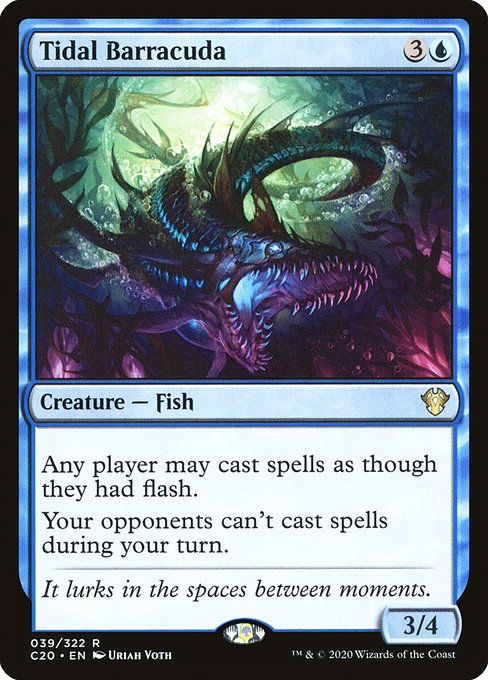
Tidal Barracuda is the definition of a high-risk, high-reward card. Giving every player at the table access to Vedalken Orrery will immediately reduce most board states to shenanigans, as anything and everything will be getting cast at the worst possible times for all plans. Assuming someone doesn’t get annoyed and destroy this card, however, you’re rewarded with a window of time during your turn that puts this chaos on pause.
This window will often represent the perfect opportunity to ensure key cards are cast without risk of counterspells, removal, or most other forms of interference. Particularly cunning players may even use Tidal Barracuda as a precursor to winning the game.
Before the group hug and combo players get too excited though, we need to discuss the risks and drawbacks this card brings to the table. First, if this card gets stolen or cloned, Tidal Barracuda will shut you down along with everyone else, which will give your opponents access to the same coveted position (and potentially game-winning benefits) we discussed a moment ago. Second, Tidal Barracuda only shuts down spells – activated and triggered abilities can still be used freely while it is out.
Finally, 4 mana is a lot to commit if you want to execute a plan the same turn this card comes down – especially when compared to similar options in white like Silence and Grand Abolisher. Sure, you get a 3/4 body with it too, but that’s really not the important part of this card. Some would even consider the body a drawback, as being a creature opens Tidal Barracuda up to a ton of commonly played removal spells. The fact that this is far easier to cast than Teferi, Mage of Zhalfir isn’t nothing though, so I’d say the benefits outweigh the drawbacks in the hands of a skilled player.
Ethereal Forager

Ethereal Forager, on the other hand, showcases the bright side of stapling a creature to a spell effect (in this case, Flood of Recollection). You’re getting an instant or sorcery of your choice back from the graveyard, plus a 3/3 flier, for 2 mana most of the time. Sure, you’ll usually have to wait a turn for the recursion, but that is an insanely efficient rate for what is effectively 2 spells (more if you’re lucky!), and if this isn’t instantly slotted into the majority of decks that can play it, I’ll be shocked.
Limiting the recursion ability to what you Delve away does remove many of the ways you can repeatedly trigger this effect, but for the average deck, that doesn’t matter in the least. Getting 4 cards in your graveyard with an instant or sorcery among them happens easily just by playing the game, so you’ll rarely have trouble getting this out for minimal mana. I’m legitimately surprised this card saw print, as many previous cards with the Delve mechanic exist on a scale between extremely powerful and rather busted. Time will tell where this one falls, I suppose.
Kalamax, the Stormsire
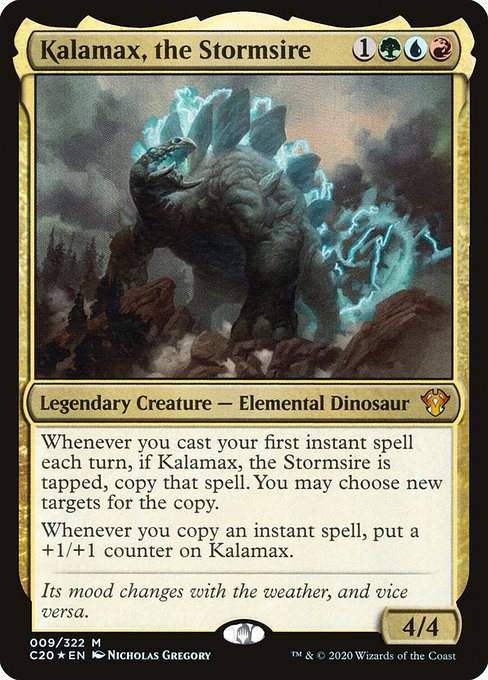
We’re going to start by addressing the elephants in the room.

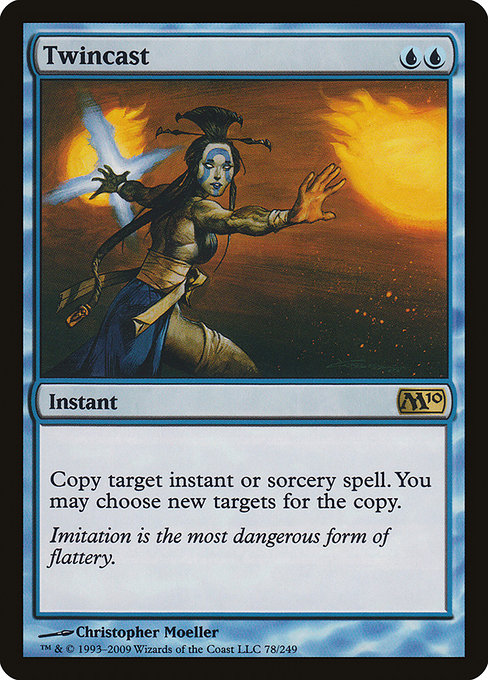
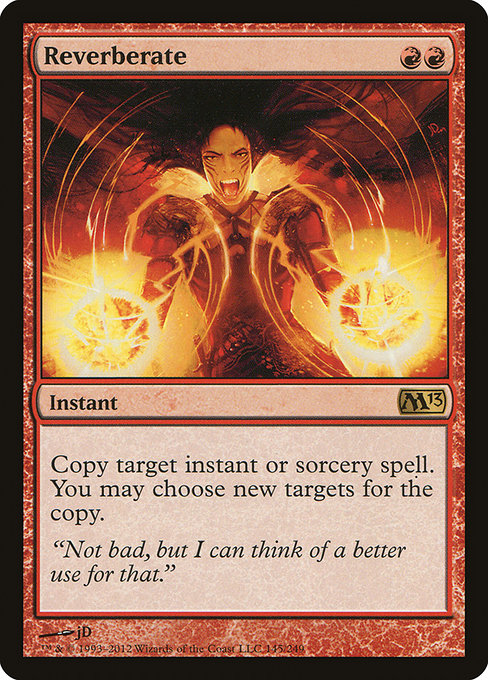
All of these, as well as similar instants, take Kalamax infinite (or to some arbitrarily high level of power and toughness) by having Kalamax‘s copy of your Fork effect copy the original, then having that new copy do the same, then repeating ad nauseum. Once you’re done juicing Kalamax with +1/+1 counters, you finally end up with two copies of whatever spell your original spell targeted to copy.
Going infinite does not guarantee your victory, however. You do have to find a way to tap Kalamax to enable this combo, so there is an extra hoop to jump through compared to other infinite loops. While attacking will often get the job done, you’re also going to be telegraphing this plan for a turn if you don’t have a pair of Lightning Greaves or Swiftfoot Boots on standby. Vigilant opponents will take advantage of this and/or alert other players to do everything in their power to shut you down.
Kalamax also does not have any inherent way to help hit your opponents once you’ve turbocharged it. You’ll need to clear a path, give it some form of evasion/trample, or use a card like Fling to get the job done. Otherwise it will just get blocked by any creature your opponents have available, since the alternative to not blocking is losing the game.
While there is little doubt some brewers are already building this version of the deck with Kalamax as a Commander anyway, Kalamax is also a pretty interesting card when included as a part of your 99. Green, blue, and red all have some pretty powerful instants at their disposal, and Kalamax‘s ability works on every turn – including your opponents’!
Copying cards like Dig Through Time, Beast Within, and Artifact Mutation on every turn is a plan I can get behind, and by the time your turn comes back around, Kalamax will be swinging at opponents for a lot more damage to boot!
Xyris, the Writhing Storm
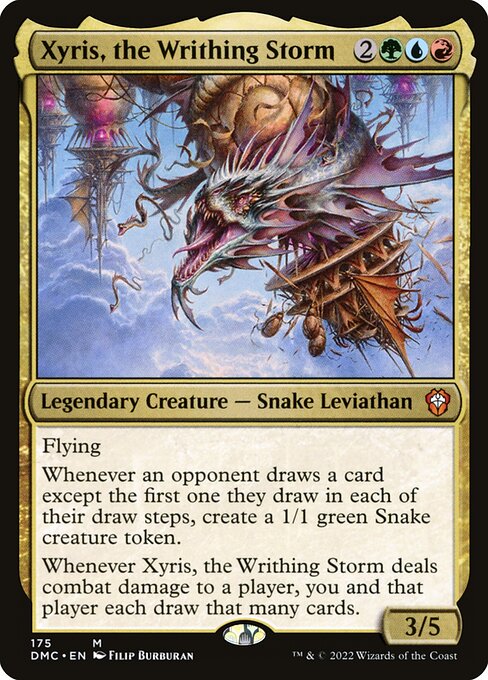
I’ll admit, I glossed over this card when it was first previewed. When a friend of mine pointed out this was basically The Locust God with green in its color identity, I gave it another look and started paying much more attention. While the Snake tokens Xyris, the Writhing Storm creates don’t have evasion like The Locust God‘s Insects, you can still easily flood the field with many of the same support cards (Windfall, Wheel of Fortune, Time Spiral, Reforge the Soul, etc.).
Xyris also offers something for the Group Hug decks out there (decks that give everyone benefits, but aim to gain slightly more than their opponents along the way). Howling Mine, Font of Mythos, Temple Bell, and Fevered Visions are just a few of the cards that synergize quite well with this token creation effect, offering an easily accessible win condition from the command zone. You can also just attack your opponent to draw 3 cards and make 3 Snakes, which many opponents will allow because it means they also get to draw free cards.
As part of the 99, I expect Xyris to be somewhat hit or miss. Some decks will really love having it available as a silver bullet against opponents that draw a lot of cards. Others will want it because they’re already playing several cards like the ones we mentioned earlier that combo incredibly well with it. If you aren’t in either of these camps, it’s still a fine card, but skipping Xyris for something that fits more in line with your strategy is completely understandable too.
Fierce Guardianship

Fierce Guardianship is part of a cycle of cards that allow you to cast them for free if your Commander is in play. The entirety of this cycle is playable, but this is one of the ones that really stands out to me. Playing countermagic is a very, very delicate thing in Commander games, especially when compared to a traditional constructed format. You’re constantly taking care not to overspend your mana so you have the ability to use a counterspell, evaluating the cards your opponents are playing to assess what is actually a threat that needs to be addressed, and trying to guess which cards your opponents are holding to ensure the most important ones never hit the field.
Often for 3 or more players simultaneously.
I play Talrand, Sky Summoner as a Commander, and use counterspells as a major focus of the deck to build up an army of Drake tokens that can then attack my opponents for the win. Trust me when I say free is the best possible cost for a counterspell – life is so much easier when you can safely spend all your mana to advance your position.
Tapping out in this fashion will also frequently embolden opponents to try for a big play. Stopping them with Force of Will or Force of Negation is not only satisfying, it has usually proven to be backbreaking too. With a third spell that can swoop in out of nowhere, so long as you have your Commander in play, control mages everywhere will all breathe a little easier (I know Pact of Negation exists, but 5 mana on the next turn is just too steep a cost outside cEDH unless you’re literally protecting or preventing a win).
If your Commander isn’t out, 3 is a little much to be paying for a Negate, but it’s still perfectly manageable in a pinch. It’s also interesting that this cycle specifies control of a commander for the cost reduction – not necessarily yours. Cards like Treachery and Gilded Drake see a fair bit of play, so the extra bit of flexibility here is definitely noted and appreciated!
Flawless Maneuver

Flawless Maneuver is, in my opinion, the crown jewel of this cycle of cards. Boros Charm, Heroic Intervention, and Teferi’s Protection all see substantial play in Commander, and while Flawless Maneuver only protects creatures, it will still be a welcome addition to this family of cards (especially since creatures are often what these cards are protecting anyway). Heck, I’d probably still play it even without the cost reduction!
The ability to shut down a variety of combat tricks and spot removal, board wipes like Blasphemous Act and Damnation, or use it in conjunction with your own board wipes to clear out opposing defenses is already pretty powerful, but then giving us the convenience of doing so for free on top of that is simply incredible. Cost reduction, as showcased earlier by the Delve mechanic, has resulted in a lot of strong and overpowered cards throughout Magic’s history, and while I don’t think Flawless Maneuver will be considered “broken”, I also think this will see an absolute ton of play from the moment it is released.
Dismantling Wave

Effects that destroy artifacts and enchantments have been around since the beginning of Magic. They aren’t always glamorous or stylish, but they’re often an extremely important and underappreciated aspect of gameplay – especially in Commander. Dismantling Wave gives you a Disenchant for every opponent, allowing you to destroy several potential issues with a single card. For an average pod, this will catch approximately 3 permanents, but the more players there are, the more value you’re going to walk away with.
Sometimes removing one artifact or enchantment per player isn’t enough though. Maybe the Voltron player is gearing up for a powerful attack, or the Memnarch player is getting just a little too greedy. Dismantling Wave can cover your bases by completely clearing the field of artifacts and enchantments too, and while 8 mana is absurdly expensive for this effect, you do also receive a few upsides:
- This ability can’t be countered by most counterspells
- This ability is available at instant speed
- You get to draw a card
This won’t always be worth the extra mana you’d pay over something like Austere Command or Cleansing Nova, but when it is, it’s probably saving you from losing the game.
Manascape Refractor
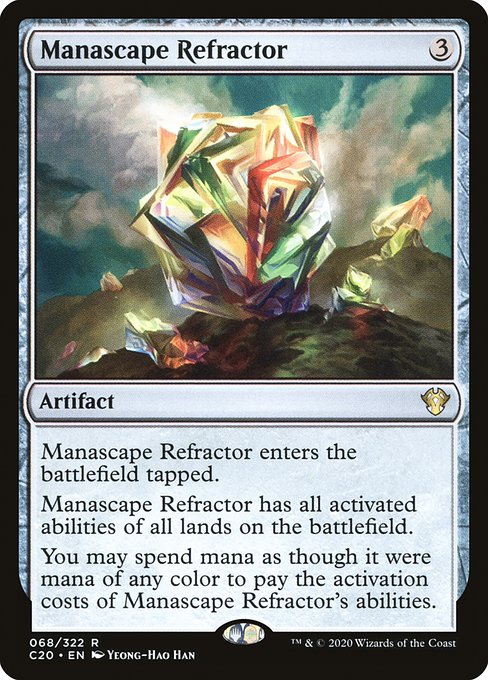
Wow. Now this is a mana rock. Yes, this enters the battlefield tapped. Yes, your mileage is going to vary from game to game and pod to pod. That doesn’t change the fact that in a 4-player game, at least one of your opponents is very likely to play something worth copying through Manascape Refractor, and if they don’t, you almost certainly will! Even if nobody manages to put something exciting into play, you’re still getting a mana rock that will tap for most, if not all, colors of mana.
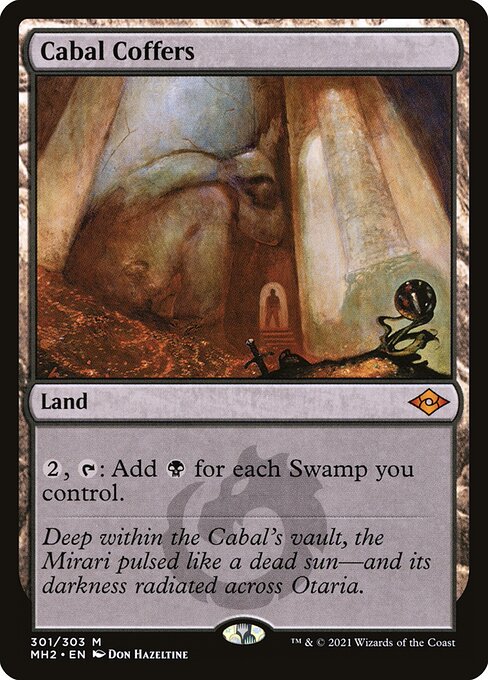


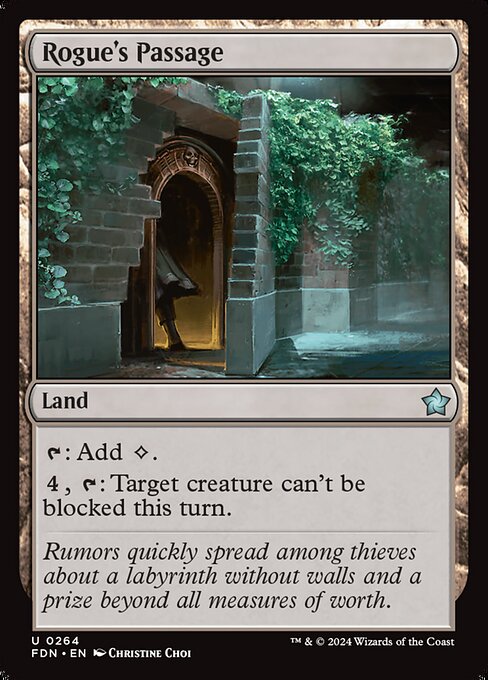
Cabal Coffers, Nykthos, Shrine to Nyx, Ancient Tomb, and Rogue’s Passage all represent just the tip of the iceberg though. There are a ton of utility lands out there you’ll be able to capitalize on, and if you’re playing some of the legendary ones, Manascape Refractor lets you safely access their abilities within a second card that is safe from the Legend Rule. You might even get to live the dream of copying something completely crazy like a Gaea’s Cradle, Bazaar of Baghdad, or Mishra’s Workshop! Being an artifact, you can also abuse Manascape Refractor with cards like Unwinding Clock and Clock of Omens for maximum value.
Not bad at all for 3 mana, and unlike something like Thespian’s Stage (which this can also copy to duck artifact removal), Manascape Refractor doesn’t really make you jump through any hoops for it to get going – it simply gives you free reign to do what you will.
That concludes my top 10 picks for Ikoria Commander 2020! As with any set, I also encourage you to have a look at the visual spoiler to see what other cards this product has to offer for your Commander decks. If you feel like I missed something, come join our Patreon and let me know through our Discord! Doing this also allows you to join an awesome community that is passionate about gaming and rewards you with some other sweet perks at higher tiers!
Other MTG Articles You May Love
- How to build a Commander EDH Deck MTG
- Top Ikoria Cards for a Commander Deck MTG
- How to Play Magic Remotely
- Untap MTG Review
- What Are Spindown Dice
Braden is a founder of Assorted Meeples and has been a gamer & writer with a vivid imagination all his life. Don’t believe us? Check out his excitement when meeting Goosebumps author R.L. Stine as a kid! An avid Magic: The Gathering spellslinger for over 15 years, you can always convince him to shuffle up for a game (or three!) of Commander.
